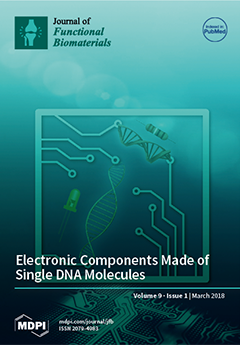A trend for the next generation of polymeric dental restoratives is to incorporate multifunctional capabilities to regulate microbial growth and remineralize tooth surfaces. Polymerizable 2-(methacryloyloxy)-
N-(2-(methacryloyloxy)ethyl)-
N,
N-dimethylethan-1-aminium bromide (IDMA1) and
N,
N′-([1,1′-biphenyl]-2,2′-diylbis(methylene))bis(2-(methacryloyloxy)-
N,
N-dimethylethan-1-aminium) bromide
[...] Read more.
A trend for the next generation of polymeric dental restoratives is to incorporate multifunctional capabilities to regulate microbial growth and remineralize tooth surfaces. Polymerizable 2-(methacryloyloxy)-
N-(2-(methacryloyloxy)ethyl)-
N,
N-dimethylethan-1-aminium bromide (IDMA1) and
N,
N′-([1,1′-biphenyl]-2,2′-diylbis(methylene))bis(2-(methacryloyloxy)-
N,
N-dimethylethan-1-aminium) bromide (IDMA2), intended for utilization in bi-functional antimicrobial and remineralizing composites, were synthesized, purified with an ethanol-diethyl ether-hexane solvent system, and validated by nuclear magnetic resonance (
1H and
13C NMR) spectroscopy, mass spectrometry, and Fourier-transform infrared spectroscopy. When incorporated into light-curable urethane dimethacrylate (UDMA)/polyethylene glycol-extended UDMA (PEG-U)/ethyl 2-(hydroxymethyl)acrylate (EHMA) (assigned UPE) resins, IDMAs did not affect the overall resins’ hydrophilicity/hydrophobicity balance (water contact angle: 60.8–65.5°). The attained degrees of vinyl conversion (DVC) were consistently higher in both IDMA-containing copolymers and their amorphous calcium phosphate (ACP) composites (up to 5% and 20%, respectively) reaching 92.5% in IDMA2 formulations. Notably, these high DVCs values were attained without an excessive increase in polymerization stress. The observed reduction in biaxial flexure strength of UPE-IDMA ACP composites should not prevent further evaluation of these materials as multifunctional Class V restoratives. In direct contact with human gingival fibroblasts, at biologically relevant concentrations, IDMAs did not adversely affect cell viability or their metabolic activity. Ion release from the composites was indicative of their strong remineralization potential. The above, early-phase biocompatibility and physicochemical tests justify further evaluation of these experimental materials to identify formulation(s) suitable for clinical testing. Successful completion is expected to yield a new class of restoratives with well-controlled bio-function, which will physicochemically, mechanically, and biologically outperform the conventional Class V restoratives.
Full article






